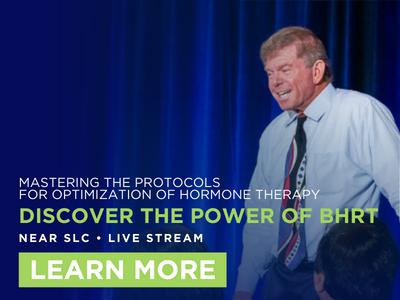
Hormone Facts You Should Know

Written by Neal Rouzier, MD
Recently the medical community has undergone criticism for journalistic articles and medical studies that promote one drug or treatment over another. There are often political or economic gains behind the purpose or results of the studies, which leads to inappropriate and biased conclusions or recommendations in these articles. This has negatively impacted the credibility of some authors and journals. Some medical journals provide a study rating score so that the reader may be able to discern any bias of a study’s treatment or product. In addition, medical journals and textbooks now use the term “evidence-based medicine” (EBM) in order to assert credibility for a medical treatment based on peer-reviewed studies or meta-analysis. The purpose of this introduction is to prevent the reader from being led astray by the political and economic bias from paid authors of medical journal papers with misleading agendas.
Evidence-Based Medicine
Many treatments, suggestions, lab tests and information presented in lectures, books and age management seminars do not follow foregoing standards of evidence-based medicine either. Exposure to these non-peer-reviewed teachings and conclusions has led me to perform extensive literature searches. I have discovered significant literature that refutes many teachings and conclusions of these anti-aging academies. For example, the trend to lower estrogen in men is contrary to scientific literature that supports the opposite. Estrogen is touted as harmful to men, causing an increase in prostate cancer; however, the literature has demonstrated a beneficial effect of estrogen in treating prostate cancer, and estrogen loss in men leads to an increase in Alzheimer’s, coronary artery disease and osteoporosis. A recent article in the NEJM proved that lowering men’s estrogen with aromatase inhibitors increases cholesterol and body fat and lowers libido and sexual function. Yet I constantly hear lecturers recommend that physicians prescribe aromatase inhibitors to men in spite of the lack of EBM to support this and the EBM that demonstrates harm of doing so.
Physicians who misunderstand the scientific literature also continue to prescribe estrogen for women in a transdermal cream to prevent the thromboembolic complications of oral estrogen, the increased incidence of which is only 4/10,000 (as per the WHI for CEE). The loss of cardiovascular protection would be negatively realized in a substantial number of women if transdermal estrogen was preferred over oral estrogen. Every NIH study and recent European studies demonstrate the cardiovascular protective effects of oral estradiol over transdermal estradiol, a fact that most physicians fail to appreciate. However, the transdermal estrogen would be expected to protect only a few women from DVT, or 4 per 10,000, but in turn lose the cardiovascular protection afforded by oral E2. The majority of cardiovascular protective benefits are attained only from oral and not transdermal estrogen. Using a transdermal estrogen prevents the cardio- vascular protection provided by oral estrogen and puts 90% of women at increased risk of cardiovascular mortality, certainly devastating in comparison to protecting 4 out of 10,000 from venous thrombosis (again for CEE). Every study to date (KEEPS, EPAT, WEST, CORA, DANISH, ELITE) where oral estradiol (E2) was utilized, the relative risk (RR) for DVT has been < 1.0 indicating no risk of DVT with oral E2, which is contrary to what everyone believes. True, there is a risk of DVT with oral estrogen, but that is seen only with oral CEE, and not oral E2. As a result, millions of women lose the most protective cardiovascular benefits of oral estrogen because physicians fear an increase in DVT that does not exist for oral E2, only for oral CEE (and that risk is not statistically significant). Still, I continuously hear that we should use only transdermal E2 over oral E2. This is why the most powerful ongoing RCT (ELITE) uses only oral E2 and not transdermal E2.
“Normal” vs “Optimal”
This concept also applies to testing hormones levels. Physicians are typically taught that if a serum level of a hormone is within a normal range, then that is all that is required. However, the medical literature refutes that concept as many patients, both men and women, will feel and function better when their levels are raised or brought to optimal levels rather than normal levels. Understanding this requires review of studies that prove a receptor site resistance, or cellular hypofunction, as is commonly understood with insulin resistance but is also present with other hormones as well. The literature provides evidence that normal is an average of a population whereas optimal is what the medical literature proves is best for you. Physicians must be taught to recognize the difference between normal and optimal hormone levels and the benefits of optimization as demonstrated by current medical studies.
Most compounding pharmacies have begun dispensing newer, cheaper yam-based estrogen (as opposed to soy-based), but physicians fail to test serum levels of hormones and thereby cannot guarantee a therapeutic serum level of estradiol, not realizing that yam sources of the estrogen prevent attaining a therapeutic level due to poor absorption and lack of micronization. Also, using a transdermal E2 that does not provide adequate serum levels, or using estriol in preference to E2 that provides no increased level of E2, will forego all of the protective musculoskeletal and cardiovascular benefits of estrogen. Many physicians promote the use of transdermal progesterone that does not provide adequate therapeutic serum levels for breast and uterine protection as per some peer-reviewed studies. Other hormone levels such as progesterone are also critical to maintain at optimal levels. In fact, the only substance shown to prevent breast cancer is progesterone, but only if high optimal serum levels are maintained. Failure to maintain these serum levels puts women at risk for breast and uterine cancer—and it must be serum levels that we optimize and not saliva levels. Many studies demonstrate that therapeutic levels of progesterone in saliva are worthless in protecting breast and uterine tissue.
Promotion of Progesterone
Progesterone is also being promoted and used by some pharmacists and physicians for prostate protection in men, whereas there no basis in fact for its use in men. On the contrary, medical literature shows that progesterone use in men has been a successful “salt peter” and increases instances of erectile dysfunction and loss of libido. Prescribing progesterone to men has also demonstrated increased vascular inflammation and risk of MI and CVA, which is the opposite of the effect seen in women. The “Y” chromosome seems incompatible with progesterone, making it harmful to men in spite of the protective benefits seen in women. Unfortunately, most physicians and pharmacists remain unaware of the phenomena associated with the various sources, forms and levels of these and other hormones. Pharmacists, physicians, and patients alike trust that all hormones dispensed are beneficial and therapeutic. However, when serum levels are tested and significantly low levels are found; this can attest to the failure of some compounded hormones to provide any benefit in spite of all the claims, which is also why ACOG and NAMS caution against BHRT.
Progesterone is also being promoted and used by some pharmacists and physicians for prostate protection in men, whereas there no basis in fact for its use in men. On the contrary, medical literature shows that progesterone use in men has been a successful “salt peter” and increases instances of erectile dysfunction and loss of libido. Prescribing progesterone to men has also demonstrated increased vascular inflammation and risk of MI and CVA, which is the opposite of the effect seen in women. The “Y” chromosome seems incompatible with progesterone, making it harmful to men in spite of the protective benefits seen in women. Unfortunately, most physicians and pharmacists remain unaware of the phenomena associated with the various sources, forms and levels of these and other hormones. Pharmacists, physicians, and patients alike trust that all hormones dispensed are beneficial and therapeutic. However, when serum levels are tested and significantly low levels are found; this can attest to the failure of some compounded hormones to provide any benefit in spite of all the claims, which is also why ACOG and NAMS caution against BHRT.
Challenging Commonly Accepted Therapies
The goal of my lectures and teaching seminars is not only to provide the physician with evidence-based literature to guide our therapy, but also to provide research that discredits commonly accepted but misguided therapies. This provides confidence and credence for the therapy the public is now demanding. To assure benefit, they must conform to the scientific standards set forth in our literature. Do not assume that any bioidentical hormone prescribed provides protective levels or is of any benefit.
The only method of assuring adequacy or benefit of a therapy is by measuring biologic endpoints, or serum markers, as is carried out in the NIH trials. Monitoring therapy and assuring adequate replacement that conforms to FDA standards should be a priority of every physician and pharmacist in order to make this therapy credible. Whatever protocol one might choose, one should then follow those research protocols that support the validity of our therapy, and then copy it to assure therapy efficacy.
Through my continuous, intensive search of the scientific literature, I’ve been able to design the BHRT Workshop Series and 1 Hour Courses to encourage rethinking our customary practice due to data or studies that support the opposite of what some academies practice or teach based on misleading articles and studies. The lectures and seminars that I teach are a potpourri of fun and interesting articles from the top peer-reviewed medical journals without bias or hidden agenda. The intent is to provide evidence-based literature to challenge our thinking, guide our practice, and prove that commonly prescribed therapies dispensed by many physicians may be harmful or lack efficacy and should be changed to conform to industry and peer-reviewed standards. The physician reviews that follow further explain the intensity of the courses and past experiences of attendees. Experience what past attendees have experienced, starting with attending Part I: Discover the Power of BHRT.
